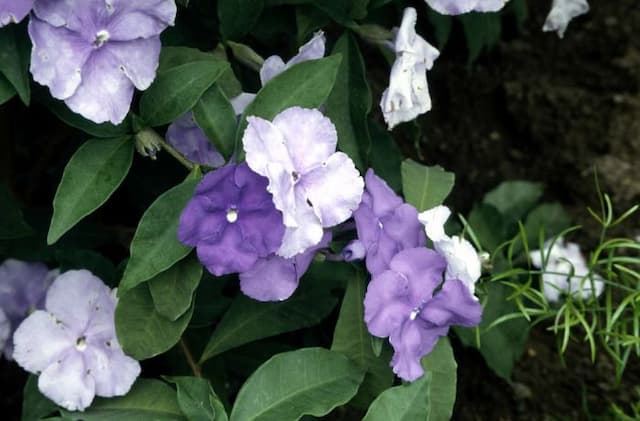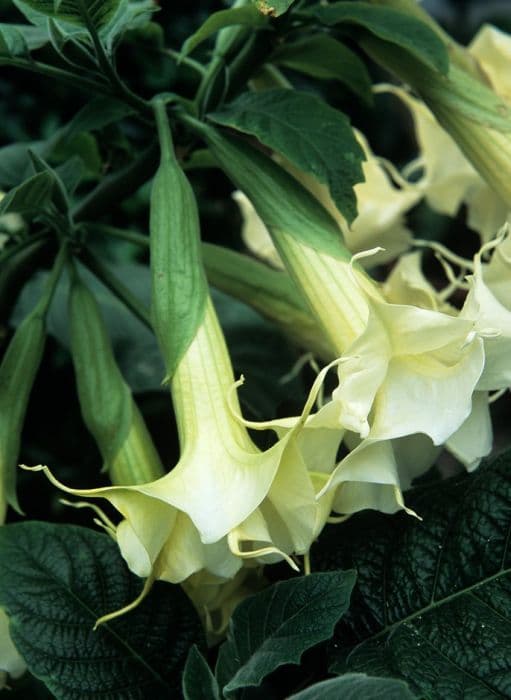Kangaroo Apple Solanum laciniatum






ABOUT
The plant known as Kangaroo Apple primarily features a lush, bushy appearance. It has deeply lobed leaves that are quite large, resembling the shape of a kangaroo's paw, which is where the name originates. The foliage can range from a bright green to a darker shade, adding a vivid splash of color to gardens. During the flowering season, the plant produces distinctive blue or purple flowers that are star-shaped. These flowers are quite striking and emerge on the tips of the foliage, giving the plant a decorative, ornamental character. The blossoms eventually give way to small, yellow-orange fruit that resembles a tiny tomato, as the plant is a member of the same family as tomatoes and potatoes. The fruit starts off green but becomes more colorful as it ripens. Kangaroo Apple's foliage, combined with its attractive flowers and fruit, makes it a popular choice for garden enthusiasts looking for an exotic and vibrant addition to their plant collection. The plant's overall structure contributes to a lush and wild appearance, often used to create a dense and tropical feel in gardens.
About this plant
 Names
NamesFamily
Solanaceae.
Synonyms
Kangaroo Apple, Large Kangaroo Apple, Cut-Leaf Nightshade.
Common names
Solanum aviculare var. laciniatum, Solanum aviculare Forst., Solanum laciniatuminum, Solanum aviculare G.Forst. var. laciniatum.
 Toxicity
ToxicityTo humans
Kangaroo apple, Solanum laciniatum, contains toxic alkaloids such as solasodine. While the ripe fruit may be less toxic and has been historically consumed by indigenous peoples when fully ripe, all other parts of the plant, especially unripe fruit, are poisonous if ingested. Symptoms may include gastrointestinal disturbances such as nausea, vomiting, abdominal pain, and diarrhea. In severe cases, ingestion could result in respiratory issues, confusion, seizures, hallucinations, and even death.
To pets
Kangaroo apple is also toxic to pets due to the presence of solasodine and related alkaloids. Ingesting any part of the plant, particularly the unripe fruit and leaves, can cause symptoms similar to those in humans. These include vomiting, diarrhea, abdominal pain, lethargy, and in severe cases, respiratory distress or neurological signs such as tremors or seizures. Consumption of the Kangaroo apple plant by pets can be potentially serious and may require veterinary attention.
 Characteristics
CharacteristicsLife cycle
Perennials
Foliage type
Evergreen
Color of leaves
Green
Flower color
Blue
Height
4-6 feet (1.2-1.8 meters)
Spread
2-3 feet (0.6-0.9 meters)
Plant type
Shrub
Hardiness zones
8
Native area
Australia
Benefits
 General Benefits
General Benefits- Ornamental Value - Solanum laciniatum, commonly known as Kangaroo Apple, has vibrant blue or purple flowers which add aesthetic beauty to gardens and landscapes.
- Wildlife Attraction - The plant's flowers and fruits attract birds and other wildlife, which can enhance biodiversity in the environment.
- Traditional Uses - Indigenous peoples have used various parts of the plant traditionally for purposes other than medicine.
- Edible Fruit - Although the unripe fruit is toxic, when fully ripe, it is edible and can be a food source for both humans and animals.
- Fast-Growing - Kangaroo Apple is a quick-growing plant, which makes it useful for establishing vegetation cover in a short period of time.
- Shelter for Fauna - Its bushy growth provides excellent shelter for small fauna, offering protection and nesting opportunities.
- Soil Improvement - As a hardy plant, it can help prevent soil erosion and improves the soil quality over time through its natural life cycle.
 Medical Properties
Medical Properties- Analgesic: Leaves have been reported to have pain-relieving properties.
- Anti-inflammatory: Traditionally used to reduce inflammation.
- Antibacterial: Exhibits activity against certain bacterial strains.
- Wound healing: Applied topically to assist in the healing of wounds.
 Air-purifying Qualities
Air-purifying QualitiesThis plant is not specifically known for air purifying qualities.
 Other Uses
Other Uses- Solanum laciniatum, commonly known as Kangaroo Apple, can be grown as a fast-growing screen or hedge in gardens due to its dense foliage.
- The fruit of Kangaroo Apple has been used as a natural soap substitute as it contains saponins which generate a lather when mixed with water.
- The plant is sometimes cultivated as an ornamental for its attractive purple flowers and bright orange fruit.
- In some cultures, the unripe fruit of Kangaroo Apple has been used to curdle milk in cheese-making processes.
- Farmers grow Kangaroo Apple as a fodder plant for livestock, though caution is advised because the plant can be toxic if not properly managed.
- The stems and leaves of Kangaroo Apple have been utilized in traditional basket weaving and as a source of fiber.
- As a nitrogen-fixing plant, Kangaroo Apple is sometimes used in permaculture and sustainable agriculture to enrich soil health.
- During drought periods, this plant can be a valuable source of moisture and nutrients for wildlife, who consume the fruit.
- Kangaroo Apple can be used in natural dye production, where parts of the plant may yield colors for fabric dyeing.
- The plant has been utilized in educational settings as a specimen to study plant biology and the Solanaceae family.
Interesting Facts
 Feng Shui
Feng ShuiThe Kangaroo Apple is not used in Feng Shui practice.
 Zodiac Sign Compitability
Zodiac Sign CompitabilityThe Kangaroo Apple is not used in astrology practice.
 Plant Symbolism
Plant Symbolism- Solitude and Isolation: Often known as the "Kangaroo Apple," Solanum laciniatum's growth habit in wild, solitary places can symbolize the need for solitude or personal space.
- Adaptation and Survival: The Kangaroo Apple's ability to thrive in various conditions mirrors the traits of adaptability and survival in difficult environments.
- Protection: In some cultures, thorny plants like the Kangaroo Apple are considered to offer protection from negative influences, much as the plant itself is protected by its thorns.
- Potential and Opportunity: The fruit of the Kangaroo Apple is toxic when green but edible when ripe, symbolizing the idea that patience can lead to rewarding and beneficial opportunities.
 Water
WaterThe Kangaroo Apple should be watered deeply once or twice a week, depending on the climate and soil drainage. Aim to keep the soil consistently moist but not waterlogged. During the growing season, you might need to water the plant with approximately 1 to 1.5 gallons per week, especially in hot, dry conditions. Reduce watering in the winter when the plant's growth slows down. It's critical to water the plant at the base and avoid wetting the foliage to prevent disease.
 Light
LightThe Kangaroo Apple thrives in full sun to partial shade conditions. It prefers a spot that receives at least six hours of sunlight per day. Place the plant in a location where it will receive morning sun and afternoon shade, especially during the hottest part of the day, to prevent leaf scorch.
 Temperature
TemperatureThe Kangaroo Apple favors a temperature range between 50°F and 86°F. It can endure brief periods down to 28°F but sustained cold below this range can damage or kill the plant. The ideal temperature for robust growth and fruiting is between 68°F and 77°F.
 Pruning
PruningPruning the Kangaroo Apple is important for maintaining its shape and encouraging healthy growth. Prune the plant in late winter or early spring before new growth starts. Remove any dead or diseased branches, and thin out dense areas to increase air circulation. The plant can be pruned annually or as needed to control its size.
 Cleaning
CleaningAs needed
 Soil
SoilThe Kangaroo Apple thrives in well-draining, fertile soil with added compost or manure to nourish the plant. A pH of 6.0 to 7.5 suits this plant best, and a mix of loam, peat, and coarse sand or perlite can aid in drainage and aeration.
 Repotting
RepottingThe Kangaroo Apple should be repotted every 2-3 years to prevent root-bound conditions and to replenish the soil, ensuring continued growth and health of the plant.
 Humidity & Misting
Humidity & MistingKangaroo Apple plants prefer moderate humidity levels, typically around 40-50%, which often reflect an average indoor environment without the need for specialized humidity adjustments.
 Suitable locations
Suitable locationsIndoor
Place Kangaroo Apple in bright, indirect light and room temperature.
Outdoor
Grow in full sun to partial shade, shelter from strong winds.
Hardiness zone
9-11 USDA.
 Life cycle
Life cycleSolanum laciniatum, commonly known as the Kangaroo Apple, begins its life as a seed, which under suitable conditions of warmth and moisture, germinates to produce a small seedling with characteristic lanceolate leaves. The seedling then grows into a juvenile plant, which develops a more robust root system and a branching stem structure. As it matures, the Kangaroo Apple enters the vegetative stage, where it continues to grow in size and mass, producing a rosette of leaves that maximize photosynthesis. After reaching a certain level of maturity, generally in its second year, it enters the flowering stage, producing distinctive purple-blue flowers that are followed by the development of yellow-orange berries when pollinated. These berries contain seeds that, once ripened and dispersed, have the potential to give rise to new plants, thus completing the reproductive cycle. The Kangaroo Apple is a perennial plant and can go through several flowering and fruiting cycles, depending on the climate and conditions, before eventually senescing and dying.
 Propogation
PropogationPropogation time
Spring to Summer
The Kangaroo Apple (Solanum laciniatum) is commonly propagated through seed sowing. The best time to propagate by seeds is in the spring after the last frost when the soil has warmed up. To propagate Kangaroo Apple using this method, you would first collect ripe fruits from the plant, which typically contain numerous seeds. Gently squash the fruits and soak them in water to help separate the seeds from the pulp. Once cleaned, the seeds can be sown directly into a well-draining seed starting mix, lightly covered with soil, and kept moist until germination, which usually takes a few weeks. Seedlings should be grown in a protected environment until they are strong enough to be transplanted outdoors. This method is advantageous as it can produce many plants from a single fruit and allows for genetic variation among the seedlings.








![Calibrachoa [Callie Mango]](/_next/image?url=https%3A%2F%2Fplants-admin.emdemapps.com%2Fimages%2Fplants%2F%2Fimages%2F604b6514b1579.png&w=640&q=75)
